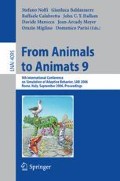Abstract
The moth Macroglossum stellatarum can learn the colour and sometimes the odour of a rewarding food source. We present data from 20 different experiments with different combinations of blue and yellow artificial flowers and the two odours honeysuckle and lavender. The experiments show that learning about the odours depends on the colour used. By training on different colour-odour combinations and testing on others, it becomes possible to investigate the exact relation between the two modalities during learning. Three computational models were tested in the same experimental situations as the real moths and their predictions were compared to the experimental data. The average error over all experiments as well as the largest deviation from the experimental data were calculated. Neither the Rescorla-Wagner model or a learning model with independent learning for each stimulus component were able to explain the experimental data. We present the new categorisation model, which assumes that the moth learns a template for the sensory attributes of the rewarding stimulus. This model produces behaviour that closely matches that of the real moth in all 20 experiments.
Access this chapter
Tax calculation will be finalised at checkout
Purchases are for personal use only
Preview
Unable to display preview. Download preview PDF.
References
Andersson, S.: Foraging responses in the butterflies Inachis io, Aglais urticae (nymphalidae), and Gonepteryx rhamni (pieridae) to floral scents. J. Chem. Ecol. 13, 1–11 (2003)
Balkenius, A., Kelber, A.: Colour constancy in diurnal and nocturnal hawkmoths. J. Exp. Biol. 207, 3307–3316 (2004)
Balkenius, A., Kelber, A.: Colour preferences influence odour learning in the hawkmoth, Macroglossum stellatarum. Naturwissenschaften, 1–4 (2006)
Balkenius, A., Kelber, A., Balkenius, C.: A model of selection between stimulus and place strategy in a hawkmoth. Adaptive Behavior 12(1), 21–35 (2004)
Balkenius, A., Rosén, W., Kelber, A.: The relative importance of olfaction and vision in a diurnal and a nocturnal hawkmoth. Journal of Comparative Physiology A: Sensory, Neural, and Behavioral Physiology 192(4), 431–437 (2006)
Brantjes, N.B.M.: Sensory responses to flowers in night-flying moths. In: Richards, A.J. (ed.) The pollinaton of flowers by insects, pp. 13–19. The Dorset Press, Dorchester (1978)
Couvillon, P.A., Arakaki, L., Bitterman, M.E.: Intramodal blocking in honeybees. Anim. Learn. Behav. 25, 277–282 (1997)
Couvillon, P.A., Campos, A.C., Bass, T.D., Bitterman, M.E.: Intermodal blocking in honeybees. Exp. Psychol. Soc. 54B, 369–381 (2001)
Couvillon, P.A., Mateo, E.T., Bitterman, M.E.: Reward and learning in honeybees: Analysis of an overshadowing effect. Anim. Learn. Behav. 24, 19–27 (1996)
Cunningham, J.P., Moore, C.J., Zalucki, M.P., West, S.A.: Learning, odour preference and flower foraging in moths. J. Exp. Biol. 207, 87–94 (2004)
Funayama, E.S., Couvillon, P.A., Bitterman, M.E.: Compound conditioning in honeybees: Blocking tests of the independence assumption. Anim. Learn. Behav. 23, 429–437 (1995)
Gallistel, R.C.: The organization of learning. MIT Press, Cambridge (1990)
Gerber, B., Ullrich, J.: No evidence for olfactory blocking in honeybee classical conditioning. J. Exp. Biol. 202, 1839–1854 (1999)
Giurfa, M., Núñez, J., Backhaus, W.: Odour and colour information in the foraging choice behaviour of the honeybee. J. Comp. Physiol. A. 175, 773–779 (1994)
Giurfa, M., Núñez, J., Chittka, L., Menzel, R.: Colour preferences of flower-naive honeybees. J. Comp. Physiol. A. 177, 247–259 (1995)
Herrera, C.M.: Activity pattern and thermal biology of a day-flying hawkmoth (Macroglossum stellatarum) under mediterranean summer conditions. Ecol. Entomol. 17, 52–56 (1992)
Kamin, L.J.: Predictability, surprise, attention and conditioning. In: Campbell, B.A., Church, R.M. (eds.) Punishment and Aversive Behavior, pp. 279–296. Appleton-Century-Crofts, New York (1969)
Kelber, A.: Innate preferences for flower features in the hawkmoth Macroglossum stellatarum. J. Exp. Biol. 200, 826–835 (1997)
Kelber, A., Hénique, U.: Trichromatic colour vision in the hummingbird hawkmoth, Macroglossum stellatarum. J. Comp. Physiol. A. 184, 535–541 (1999)
Kelber, A., Vorobyev, M., Osorio, D.: Animal colour vision - behavioural tests and physiological concepts. Biol. Rev. 78, 81–118 (2003)
Kunze, J., Gumbert, A.: The combined effect of color and odor on flower choice behavior of bumble bees in flower mimicry systems. Behav. Ecol. 12, 447–456 (2001)
Luo, R.C., Kay, M.G.: Data fusion and sensor integration: state-of-the-art 1990s. In: Abidi, M.A., Gonzalez, R.C. (eds.) Data Fusion in Robotics and Machine Intelligence. Academic Press, Boston (1992)
Mackintosh, N.J.: The Physiology of Animal Learning. Academic Press, London (1974)
Menzel, R.: Untersuchungen zum erlernen von spektralfarben durch die honigbiene (Apis mellifica). Z. t vergl. Physiol. 56, 25–37 (1967)
Pavlov, I.P.: Conditioned Reflexes. Oxford University Press, Oxford (1927)
Pelz, C., Gerber, B., Menzel, R.: Odorant intensity as a determinant for olfactory conditioning in honeybees: roles in discrimination, overshadowing and memory consolidation. J. Exp. Biol. 200, 837–847 (1997)
Pfaff, M., Kelber, A.: Ein vielseitiger Futterspender für anthophile Insekten. Entomol. Zt. 113, 360–361 (2003)
Raguso, R.A., Willis, M.A.: Synergy between visual and olfactory cues in nectar feeding by naive hawkmoths, Manduca sexta. Anim. Behav. 64, 685–695 (2002)
Rowe, C.: Receiver psychology and the evolution of multicomponent signals. Anim. Behav. 58, 921–931 (1999)
Srinivasan, M.V., Zhang, S.W., Zhu, H.: Honeybees links sight to smell. Nature 396, 637–638 (1998)
von Frisch, K.: Der Farbensinn und Formensinn der Biene. Zool. Jb. Abt. Zool. Physiol. 15, 193–260 (1914)
von Frisch, K.: Über den Geruchssinn der Bienen und seine blütenbiologische Bedeutung. Zool. Jb. Abt. Zool. Physiol. 37, 2–238 (1919)
Weiss, M.: Innate colour preferences and flexible colour learning in the pipevine swallowtail. Anim. Behav. 53, 1043–1052 (1997)
Weiss, M.: Vision and learning in some neglected pollinators: beetles, flies, moths, and butterflies. In: Chittka, L., Thomson, J.D. (eds.) Cognitive Ecology of Pollination, pp. 171–190. Cambridge University Press, Cambridge (2001)
Zentall, T.R., Riley, D.A.: Selective attention in animal discrimination learning. J. gen. Psychol. 127, 45–66 (2000)
Author information
Authors and Affiliations
Editor information
Editors and Affiliations
Rights and permissions
Copyright information
© 2006 Springer-Verlag Berlin Heidelberg
About this paper
Cite this paper
Balkenius, A., Kelber, A., Balkenius, C. (2006). Modelling Multi-modal Learning in a Hawkmoth. In: Nolfi, S., et al. From Animals to Animats 9. SAB 2006. Lecture Notes in Computer Science(), vol 4095. Springer, Berlin, Heidelberg. https://doi.org/10.1007/11840541_35
Download citation
DOI: https://doi.org/10.1007/11840541_35
Publisher Name: Springer, Berlin, Heidelberg
Print ISBN: 978-3-540-38608-7
Online ISBN: 978-3-540-38615-5
eBook Packages: Computer ScienceComputer Science (R0)

